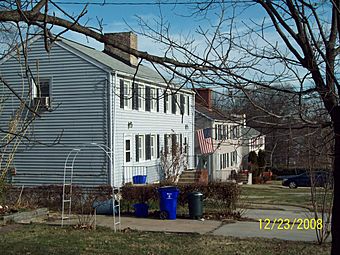Savage Mill Historic District facts for kids
Quick facts for kids |
|
|
Savage Mill Historic District
|
|

Savage Mill Workers Housing, December 2008
|
|
| Location | N of Little Patuxent River off U.S. 1, Savage, Maryland |
|---|---|
| Area | 50 acres (20 ha) |
| Built | 1822 |
| Architectural style | Late Victorian, Federal |
| NRHP reference No. | 75000905 |
| Added to NRHP | February 20, 1975 |
The Savage Mill Historic District is a special historical area located in Savage, Maryland, in Howard County, Maryland. It includes the old Savage Mill factory buildings and the village where the factory workers used to live. This area is important because it shows how factories and towns grew together a long time ago.
A Look Back at Savage Mill
The land where Savage Mill stands has been used for factories since the early 1700s. It's right by the fast-moving Little Patuxent River. In 1750, a man named Alexander Warfield built a mill here. Later, in 1812, the Williams Brothers started a much bigger factory.
What the Mill Made
By 1825, the mill was a busy place. About 200 people worked there, including women and children. They used 120 special machines called power looms. These machines helped them make a strong fabric called "cotton duck." This fabric was often used for things like sails and tents.
The mill complex also had other important parts. There was a grist mill, which ground grain into flour. There was also an iron foundry, where metal was melted and shaped. A machine shop helped fix and build new equipment for the factory.
Changes Over Time
In 1847, a businessman named William H. Baldwin, Jr. bought the mill. He owned a large dry goods company in Baltimore. The mill continued to grow and change over the years.
In the early 1900s, the company became Baldwin, Leslie and Company. They made the mill even bigger. About ten years later, the Baldwin family built a stone community hall for the town. This hall was a place for people to gather. They also built many houses for the workers to rent.
From 1923 to 1941, the Carroll Baldwin Memorial Community Hall was used as a movie theater! For a short time, from 1927 to 1929, the Maryland State Police even had a small office there.
The Mill During World War II
By 1941, the Savage Mill employed 325 people. During World War II, the mill played an important role. It produced a huge amount of cotton duck fabric, about 400,000 pounds every month! This fabric was vital for the war effort.
The Mill Closes
After many years of operation, the mill closed in 1948. In the 1950s, it had a brief new life making Christmas ornaments. But then it closed permanently. Today, the old mill buildings have been changed and are now used for shops and businesses.
The Savage Mill Historic District was added to the National Register of Historic Places in 1975. This means it is recognized as an important historical site in the United States.
Images for kids






